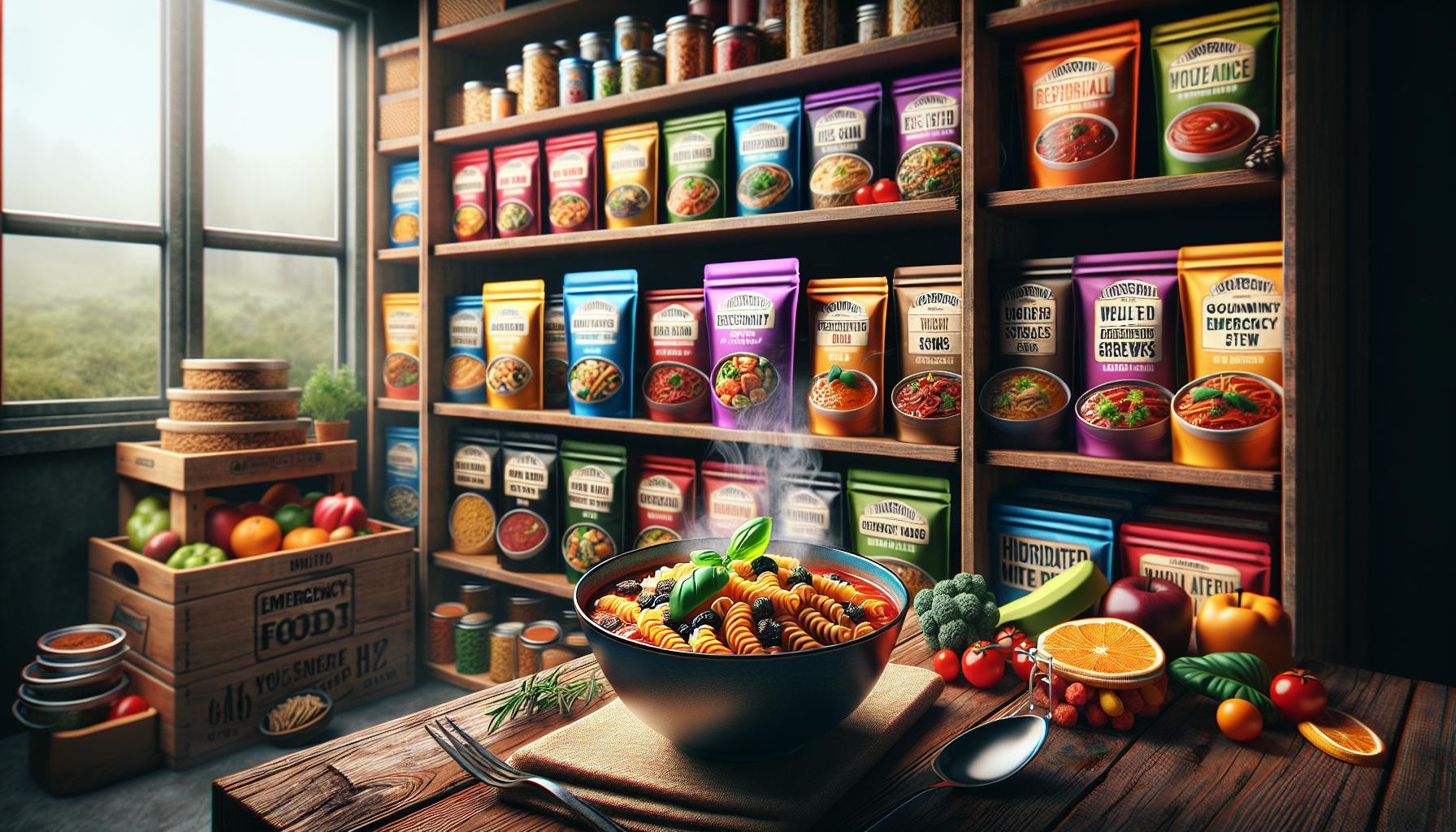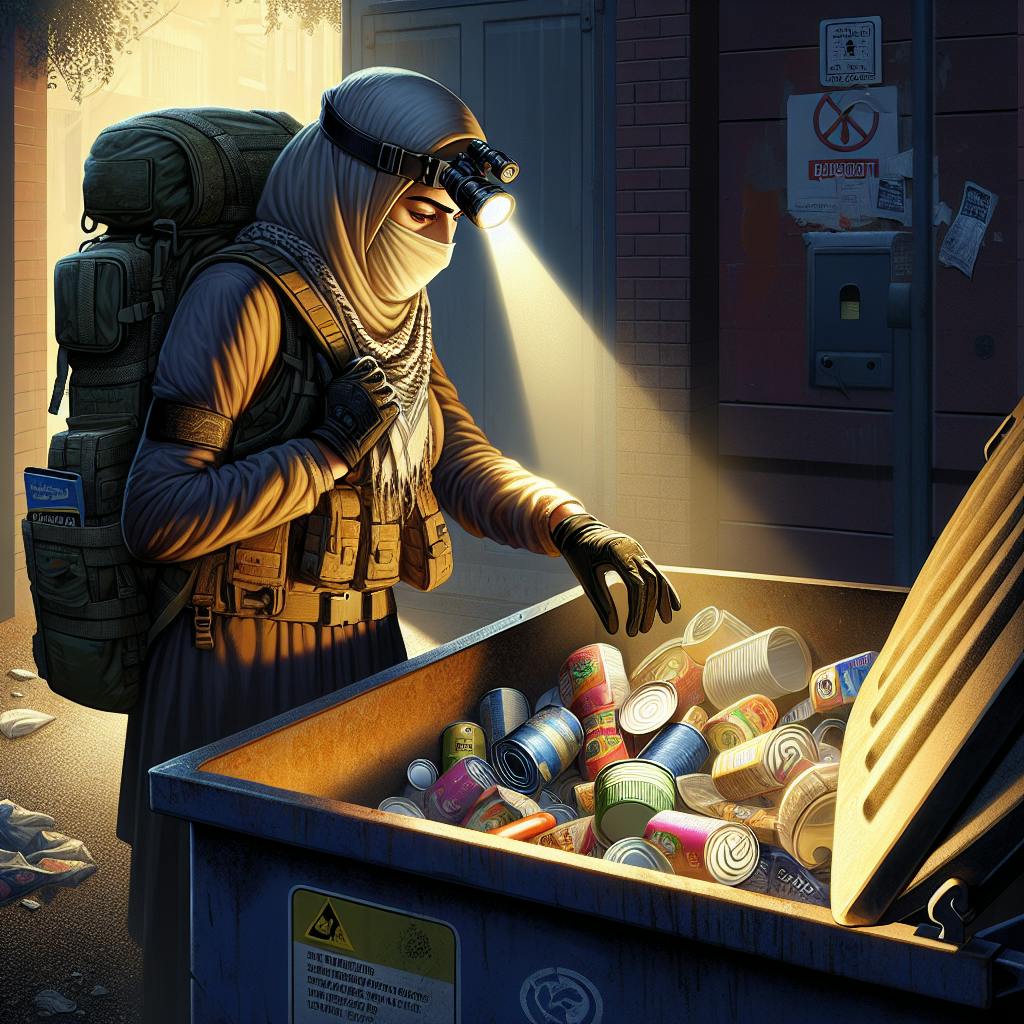Prepping entails gathering gear to prepare for emergencies or disasters.
This guide outlines the most essential items every prepper should have in their stockpile, from water filtration to first aid kits, emergency food, shelter solutions, and more.
We'll explore the key factors in choosing quality gear over quantity, providing specific product recommendations in each category to help build your preparedness supplies.
Introduction to Prepping Essentials
Prepping essentials are the fundamental items every prepper should have on hand to ensure readiness for emergencies or disasters. When building your stockpile, it's important to focus on versatile, multi-purpose gear rather than accumulating a large quantity of niche items.
Here are some of the most essential categories of gear to include:
Water Filtration and Storage
Having access to clean drinking water is critical in an emergency. Items like portable water filters, collapsible jugs, and water purification tablets take up little space but can prove invaluable. Choose options that filter bacteria and viruses for maximum effectiveness.
Emergency Shelters
A reliable shelter like the Arcturus Emergency Tarp provides protection from the elements if you need to evacuate your home. Opt for durable, waterproof materials that can withstand extreme weather.
Tools and Lighting
A solid fixed-blade field knife, paracord, and radios facilitate survival tasks like building shelters, fishing, and staying informed. Solar-powered lights provide illumination without batteries.
First Aid
Trauma kits equipped to treat major injuries allow you to stabilize medical situations when professional help is unavailable. Also consider basic supplies like bandages and disinfectants.
By focusing your preparedness efforts on versatile essentials like these, you'll be able to weather a wider range of emergencies without advanced warning. Choose durable, portable equipment suitable for your climate and potential risks. With practice using your gear, you can handle adversity confidently.
Water Filtration and Purification
No prepper stockpile is complete without reliable access to clean drinking water. Having quality water filtration systems and purification methods ensures your family will have safe drinking water in an emergency situation.
Choosing the Best Water Filtration Systems
When selecting a water filtration system, portability and flow rate are key factors to consider. The Sawyer Mini Filter is a top choice for backpackers and preppers. Weighing only 2 ounces, this compact filter screws onto most water bottles and filters up to 100,000 gallons. For larger groups, the Big Berkey Gravity Filter has a fast flow rate up to 4 gallons per hour and connects directly to large storage containers.
Other excellent portable water filter options include the LifeStraw Personal Water Filter and Survivor Filter Pro. When selecting any water filtration system, look for certifications like NSF International or Water Quality Association, indicating the filter is proven to remove bacteria, chemicals, heavy metals and other contaminants.
25 Items Every Prepper Should Stockpile: Water Purification Tablets
Water purification tablets like Potable Aqua are an inexpensive backup option for purifying water in emergency situations when filters are not available. These chlorine dioxide tablets kill 99.99% of bacteria, viruses and protozoan cysts like Giardia that can contaminate water sources. Just add one tablet per quart or liter and wait 30 minutes before drinking. Potable Aqua tablets come in portable tubes or larger bottles. Stockpile at least 6 months' supply for your family based normal daily water needs. Other top water purification tablet brands are Aquatabs and Katadyn Micropur.
Secure Water Storage Solutions
Water weighs over 8 pounds per gallon, so plastic and stainless steel are preferred over glass for portability. The Reliance Rhino Heavy Duty Water Container holds 7 gallons, has a spigot for easy pouring and carrying handle. For larger volume, connect several 55 gallon plastic drums together with a gravity kit like the WaterBrick International Emergency Water Storage System. Use only food-grade plastic containers labeled BPA-free. Properly cleaned and sealed stainless steel containers are extremely durable for long term water storage. Allow 1 gallon per person daily for drinking, cooking and hygiene.
Unique Prepper Items: Advanced Water Purification
Some unique water purification methods for preppers include reverse osmosis filters like the Katadyn Survivor 35, UV light systems like the SteriPEN Ultra, and even atmospheric water generators like the Watergen for Home. These advanced systems can turn saltwater or contaminated water into pure, safe drinking water using filtration membranes, sterilizing UV rays or condensation technology. Though expensive, for preppers in coastal regions or areas with frequent water contamination events, these systems provide reliable access to clean water even in dire situations.
First Aid Preparedness
Being prepared to effectively treat injuries, wounds or illness without access to medical facilities is a key pillar of prepping. We explore first aid supplies every prepper should have.
Comprehensive Trauma Kit Essentials
We recommend stocking multiple trauma kits for your home, bug out bag, and vehicles that contain essentials like bandages, ointments, medicines, surgical tools, and more.
Some key items to include:
- Adhesive bandages
- Gauze pads and rolls
- Triangular bandages
- Elastic bandages
- Antiseptic wipes and ointment
- Burn cream
- Sterile gloves
- Tweezers
- Scissors
- Safety pins
- Thermometer
- Basic medications like ibuprofen, antihistamines
Tailor kits for your needs. For example, add splints and wraps if prone to fractures or sprains. Those with allergies may pack epinephrine auto-injectors.
Rotate stock to avoid expiration. Inspect contents regularly and restock as needed.
Alternative Medicines and Prepper Stockpile Items
Beyond mainstream pharmaceuticals, alternative remedies like antimicrobial essential oils, activated charcoal, medicinal herbs, and potassium iodide tablets play an important role.
- Tea tree and oregano oils have natural antibacterial properties to treat cuts or infections.
- Charcoal absorbs toxins from accidental poisoning.
- Elderberry can help fight viruses. Garlic boosts immunity.
- Potassium iodide protects the thyroid gland from radiation exposure.
When using alternatives, verify safety and efficacy from reputable sources. Can complement traditional medicine when used judiciously.
Prepper Supplies Checklist PDF: Medical Reference Materials
Having offline access to authoritative medical references for emergency treatment, drug information, diagnosis, and procedures can prove invaluable.
Print or download digital copies of:
- First aid manuals
- Prescription info sheets
- Anatomy charts
- Surgical instructions
- Medicinal plant guides
- General health references
Store in Faraday bags or cages to protect from EMPs. Refresh content annually to stay current.
Unique Prepper Items: Specialized Medical Supplies
Discussion of less common but potentially life-saving medical supplies that can give preppers an edge in health-related emergencies.
- Suture kits with needles, thread, scissors, forceps
- Super glue for minor lacerations
- Dental repair kits
- Chest seals for puncture wounds
- Tourniquets to control bleeding
- Nasopharyngeal airways for obstructed breathing
- Sam splints for fractures
With training, these items enable emergency treatment beyond basic first aid skill. Can buy premade kits or assemble your own.
Emergency Food Supplies
Stockpiling enough non-perishable food to feed your family if SHTF is non-negotiable. Having a diverse set of emergency food supplies on hand can provide sustenance and nutrition when access to fresh food is limited.
The Prepper's Pantry: Canned and Jarred Goods
Canned goods like vegetables, fruits, soups and meats can supply calories and nutrients for long periods if stored properly. Focus on versatile, nutritious options over tasty treats. Some good choices include:
- Canned tuna, salmon, chicken for protein
- Canned beans, vegetables, fruits for carbs and nutrients
- Canned soups and stews with meat and veggies
- Jarred nut butters for fats and protein
Rotate stock regularly to ensure freshness and quality.
Stockpile List Items Survival: Grains, Beans, and Legumes
Dried goods like rice, pasta, oats, beans, and lentils are calorie-dense staples with long shelf lives, especially if stored airtight and oxygen-free. Consider adding:
- White rice, brown rice, wild rice
- Dried beans like pinto, black, kidney
- Lentils
- Rolled oats or quick oats
- Pasta noodles
These basics form the foundation of a layered food stockpile.
Essential Fats and Oils for Long-Term Storage
In addition to protein, carbs and nutrients, dietary fats provide energy and support health. Consider storing:
- Cooking oils like olive, avocado, coconut
- Shelf-stable snacks like nuts, seeds, nut butters
- Powdered butter, shortening, lard
Rotate stock before expiration and store cool and dark.
Best Prepper Items on Amazon: Emergency Food Ration Bars
Emergency food bars available on Amazon offer lightweight, nutrient-dense calories perfect for bug out bags:
- Datrex Emergency Food Ration Bars: With 5 years shelf life, 400 calories per bar
- S.O.S. Food Lab Bars: Provide fat, carbs and protein in every bar
- Survival Tabs: Extremely compact tabs contain vitamins and minerals
Compare nutritional info to find the best option for your needs.
sbb-itb-b932644
Essential Gear and Tools
Beyond food and medicine, survival necessities like shelter, water, fire and communication must be covered. We explore versatile gear every prepper should own.
Shelter Solutions: From Emergency Shelters to Heavy Duty Tarps
Reliable all-weather shelter is a must-have prepper item. We review durable tents, tarps, bivys, sleeping gear and insulating layers to survive the elements.
The Arcturus Emergency Tarp is an excellent lightweight tarp that can provide lifesaving shelter in an emergency situation. At 10 x 7 feet, it's large enough to shelter 2-3 people. The 210T ripstop polyester material is waterproof, windproof, and tear resistant while packing down small. Use paracord or rope to secure it. Pair it with an insulated sleeping pad and sleeping bag for warmth.
Another option is a 4 season backpacking tent for longer term shelter needs. The ALPS Mountaineering Lynx 2 person tent provides ample space and vestibules while weighing under 5 pounds. The polyester fly resists UV damage and seals out rain, while the aluminum poles and floor frame provide structure. Stay warm with the vestibule space to store gear.
For more portable shelter, a bivy sack like the Outdoor Research Alpine Bivy provides an individual sized weatherproof cocoon. Pair it with a sleeping bag and sleeping pad, using trekking poles or tree branches to keep the mesh off your face. Bivys excel in rocky or sloped terrain where tents can't pitch.
Fire Starting Essentials: Fire Kit and Fire Rods
The ability to produce flame is critical. We recommend carrying multiple fire starting aids like weatherproof matches, flint strikers, blastmatches and firesteel.
The Ultimate Survival Technologies Blastmatch firestarter uses fuel and an ignition tip to create a windproof flame up to 15,000 degrees Fahrenheit. It's reusable for up to 1,000 ignitions. Alternately, stormproof matches, flint strikers, and firesteel products create sparks to ignite tender.
We recommend a fire starting kit like the Ultimate Survival Tech Magnesium Survival Fire Kit. It contains a firesteel rod, striker, stormproof matches, tinder, candle, and waterproof case to keep it all dry. With multiple ignition sources, you're covered in any survival fire starting scenario. Practice with your gear before an emergency.
Survival Blades: Field Knife Selection and Knife Sharpener
A good fixed-blade knife plus a multi-tool can serve countless survival needs from shelter building to food prep and gear repairs. We suggest quality brands and useful models.
The Benchmade - Steep Country 15008-2 hunting knife has a 3.5 inch drop point blade ideal for detail work. Made in the USA from premium CPM-S30V steel, it holds an edge exceptionally well, resisting corrosion too. The ergonomic handle and lanyard hole keep it secure in hand. Use the integrated gut hook to field dress game.
Maintain your knife's edge with the Lansky Deluxe 5 Stone Sharpening System. The coarse, medium, fine, extra fine and ceramic stones let you customize the bevel. The guide rods hold the blade angle for consistent results. Lubricate stones with water or oil. An alternate pocket sharpener is the Smith's PP1 Pocket Pal Multifunction Sharpener.
Prepper Gear List: Multitools and Cordage
Diving into the essential multitools and varieties of cordage that can be lifesavers in countless survival scenarios.
A multitool like the Leatherman Signal or Victorinox SwissTool Spirit X provides pliers, knives, screwdrivers, can opener, saw and more in one tool. The clamshell design fits better in pockets than handles with folded tools. Use oil to prevent rust.
Cordage is vital for shelter building, animal snares, gear repairs and packing loads. 550 paracord contains 7 inner strands within a tough nylon sheath. Tested to hold 550 pounds, it has tremendous strength for its light weight. Use the inner strands as thread or fishing line. Wire saws like the Rapid Rope cut through wood up to 6 inch diameter branches. Pair it with several lengths of utility cord.
Bug Out Bags and Evacuation Plans
Every prepper should have a well-stocked bug out bag ready to go in case of an emergency evacuation. This bag should contain the essentials to survive for at least 72 hours away from home.
Essential Bug Out Gear: Building Your Kit
When building your bug out bag, focus on the core survival basics:
- Shelter: Pack an emergency tarp or tube tent to provide overhead protection. A lightweight, packable sleeping bag is also essential.
- Water: Have at least 1 gallon of water per person for 3 days. Water filtration devices like Lifestraws effectively filter pathogens.
- Food: Pack high-calorie, non-perishable foods like protein bars, dried fruits and nuts. MREs also provide balanced nutrition.
- First Aid: A compact first aid kit with bandages, gauze, ointments, medications and tools helps treat injuries.
- Tools: A good knife, flashlight, fire starter, rope/cordage and duct tape have a variety of uses from shelter building to signaling.
- Power: Pack spare batteries, a crank or solar powered charger. A Faraday bag shields electronics from EMPs.
- Documents: Copies of key personal documentation help prove identity and access resources.
Bugging Out with Children: Family-Specific Preparations
When bugging out with kids, tailor preparations to their unique needs:
- Pack child-sized clothing layers and footwear suitable for the climate.
- Bring comforting items like stuffed animals, books and puzzles for entertainment.
- Include kid-friendly foods, snacks, water bottles and utensils.
- Prepare for medical needs with medications, diapers, wipes, etc.
- Set up an emergency contact protocol for getting separated. ID wristbands help.
Strategic Relocation: Bug Out to Secondary Locations
Identify backup bug out locations with extended family or friends in case your home is uninhabitable. Public lands can also potentially provide temporary refuge.
- Friends/Family: Mutual aid agreements provide shelter. Pre-position some supplies.
- Public Lands: National/state parks, forests offer space. Research dispersed camping regulations.
In either case, have detailed maps and navigation tools to travel safely. Share trip plans with your support network.
Prepper Gear and Supplies: Customizing Your Bug Out Bag
Tailor your bug out bag to your needs by researching product options for critical gear:
- Shelter: Emergency tents, tarps, bivys, hammocks
- Water: Gravity filters, UV purifiers, desalinators
- Food: MREs, freeze dried meals, ration bars
- Power: Crank, solar chargers, generators, batteries
- Tools: Fixed, folding and tactical knives for versatility
Prioritize quality over quantity so gear performs when needed most. Conduct test runs to confirm your bag has the right items to sustain your household.
Specialized Preps and Projects
Next-level preppers may want to explore more advanced areas like communications, security, renewables and homesteading. We provide starting points for those looking to go deeper.
Emergency Communications: Radios and Faraday Cage
Having reliable communication methods during an emergency is critical for coordination and accessing help. We recommend considering emergency radios that operate on multiple bands without relying on infrastructure. Key features to look for include:
- Multiple bands (VHF, UHF, shortwave, AM/FM bands)
- NOAA weather radio
- Hand crank and solar charging
- Phone charging capability
- Range of 10+ miles
Storing the radio in a Faraday cage can protect against damaging EMPs. A basic cage can be made from a metal trash can lined with cardboard.
Advanced Prepper Projects: Solar Generators and Solar Freeze Dryers
Expanding your self-reliance through renewable energy and food preservation allows you to operate independently of traditional infrastructure.
Solar generators harness the sun's energy for electricity to power devices, appliances, tools or even your home. Complete turnkey systems are available or can be DIYed.
Solar freeze dryers use solar thermal heat to remove moisture from food to extend shelf life up to 25 years. Great for long-term food stockpiles.
Renewable Energy Solutions for Preppers
Besides solar, preppers can leverage wind, hydroelectric, and geothermal sources for reliable electricity. We recommend starting with smaller scale projects before expanding capacity.
Wind turbines can be installed on rural properties to trickle charge batteries. Mini hydroelectric systems tap into flowing water from streams or springs. Geothermal heat pumps use underground temperatures for efficient heating and cooling.
Prepper Supplies Clearance: Finding Deals on Essential Gear
Stocking up on quality gear and supplies is costly. We suggest monitoring prepper-focused online stores for sales, clearance items and coupon codes to save money. Local thrift stores and garage sales can also yield hidden gems. Focus on essential items first before specialty gear.
Final Tips for Building Your Prepper Stockpile
As you build your stockpile of essential prepper gear, here are some final tips to keep in mind:
Continually Reassess and Rotate
- Take inventory of your stockpile at least twice a year and replace any expired or damaged items.
- Rotate your stock using the "first in, first out" method to avoid waste.
- Reevaluate your needs as your situation changes - add or remove items as necessary.
Focus on Skills as Well as Stuff
- Gear is useless without the know-how. Take courses in emergency first aid, self-defense, hunting, etc.
- Practice key skills like fire starting, filtering water, and repairing gear. Muscle memory is invaluable in an emergency.
Connect with Like-Minded Neighbors
- Get to know who around you shares similar interests in preparedness.
- Share knowledge, coordinate efforts, and help each other out. There is strength in numbers.
By keeping these tips in mind as you build your stockpile over time, you'll create a comprehensive, sustainable resource that will serve you well when you need it most.


